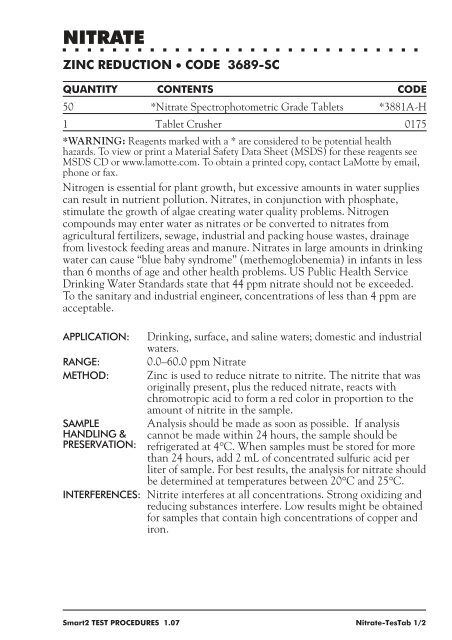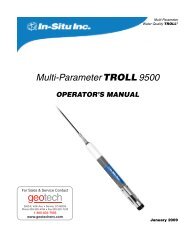TEST INSTRUCTIONS - Geotech Environmental Equipment
TEST INSTRUCTIONS - Geotech Environmental Equipment
TEST INSTRUCTIONS - Geotech Environmental Equipment
You also want an ePaper? Increase the reach of your titles
YUMPU automatically turns print PDFs into web optimized ePapers that Google loves.
NITRATE<br />
ZINC REDUCTION CODE 3689-SC<br />
QUANTITY CONTENTS CODE<br />
50 *Nitrate Spectrophotometric Grade Tablets *3881A-H<br />
1 Tablet Crusher 0175<br />
*WARNING: Reagents marked with a * are considered to be potential health<br />
hazards. To view or print a Material Safety Data Sheet (MSDS) for these reagents see<br />
MSDS CD or www.lamotte.com. To obtain a printed copy, contact LaMotte by email,<br />
phone or fax.<br />
Nitrogen is essential for plant growth, but excessive amounts in water supplies<br />
can result in nutrient pollution. Nitrates, in conjunction with phosphate,<br />
stimulate the growth of algae creating water quality problems. Nitrogen<br />
compounds may enter water as nitrates or be converted to nitrates from<br />
agricultural fertilizers, sewage, industrial and packing house wastes, drainage<br />
from livestock feeding areas and manure. Nitrates in large amounts in drinking<br />
water can cause “blue baby syndrome” (methemoglobenemia) in infants in less<br />
than 6 months of age and other health problems. US Public Health Service<br />
Drinking Water Standards state that 44 ppm nitrate should not be exceeded.<br />
To the sanitary and industrial engineer, concentrations of less than 4 ppm are<br />
acceptable.<br />
APPLICATION: Drinking, surface, and saline waters; domestic and industrial<br />
waters.<br />
RANGE: 0.0–60.0 ppm Nitrate<br />
METHOD: Zinc is used to reduce nitrate to nitrite. The nitrite that was<br />
originally present, plus the reduced nitrate, reacts with<br />
chromotropic acid to form a red color in proportion to the<br />
SAMPLE<br />
HANDLING &<br />
PRESERVATION:<br />
amount of nitrite in the sample.<br />
Analysis should be made as soon as possible. If analysis<br />
cannotbemadewithin24hours,thesampleshouldbe<br />
refrigerated at 4C. When samples must be stored for more<br />
than 24 hours, add 2 mL of concentrated sulfuric acid per<br />
liter of sample. For best results, the analysis for nitrate should<br />
be determined at temperatures between 20Cand25C.<br />
INTERFERENCES: Nitrite interferes at all concentrations. Strong oxidizing and<br />
reducing substances interfere. Low results might be obtained<br />
for samples that contain high concentrations of copper and<br />
iron.<br />
Smart2 <strong>TEST</strong> PROCEDURES 1.07 Nitrate-TesTab 1/2

















